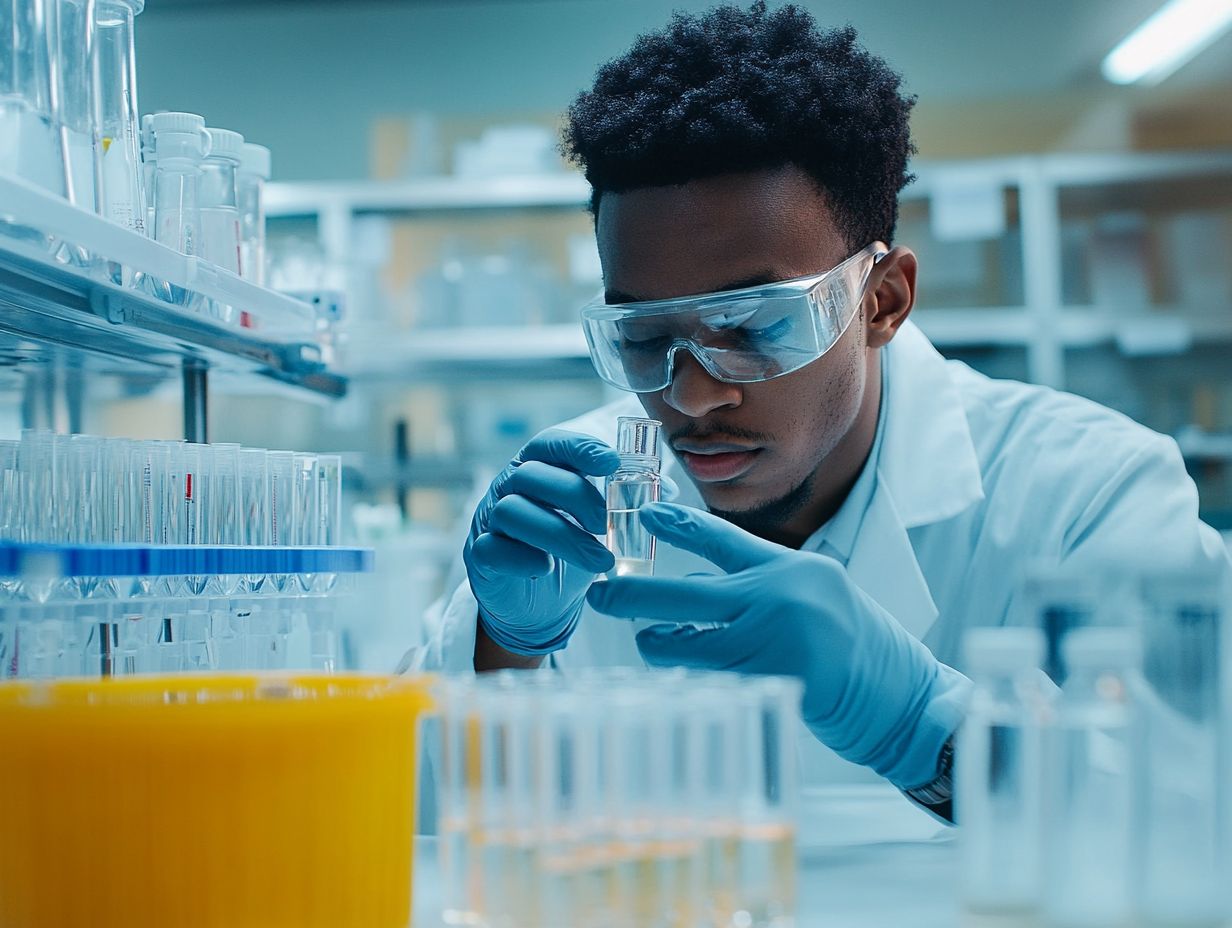Water Quality Testing: Essential Methods
Water quality testing is vital for your health. Contaminated water can lead to serious health issues, making it crucial to understand the common pollutants in your drinking supply.
This article explores various types of contaminants and their sources. It also covers methods to assess water quality, including chemical, biological, and physical analyses. Additionally, you ll find guidance on interpreting test results and practical steps to ensure your drinking water is safe and clean.
Dive in now! Learn how you can protect your health and improve water quality in your community.
Contents
- Key Takeaways:
- Why is Water Quality Testing Important?
- Common Contaminants in Water
- Methods for Testing Water Quality
- Interpreting Water Quality Test Results
- Ensuring Safe Drinking Water
- Frequently Asked Questions
- What is water quality testing and why is it important?
- What are the essential methods for water quality testing?
- How is pH testing done in water quality testing?
- What does dissolved oxygen testing reveal about water quality?
- What is turbidity and how is it measured in water quality testing?
- How frequently should water quality testing be done?
Key Takeaways:

- Regular water quality testing is crucial for maintaining safe and healthy drinking water.
- Contaminants like heavy metals, bacteria, and physical impurities can harm health and must be identified and treated.
- Chemical, biological, and physical testing methods are essential for accurately assessing water quality and identifying potential risks.
Why is Water Quality Testing Important?
Water quality testing is essential to ensure the safety of your drinking water. It helps identify harmful contaminants that could pose serious health risks.
Not testing water can lead to pollution. This harms human health and threatens the environment, aquatic life, and ecosystems. The World Health Organization (WHO) and the Centers for Disease Control and Prevention (CDC) emphasize that regular water testing is vital for preventing waterborne diseases and advancing Sustainable Development Goals related to clean water and sanitation.
Impact of Poor Water Quality on Health
Poor water quality poses serious health risks, exposing you to waterborne diseases caused by germs and hazardous chemical pollutants like heavy metals.
Exposure to toxins like E. coli or elevated levels of ammonia, nitrite, and nitrate can lead to severe illnesses, especially among vulnerable groups like children and the elderly.
The Centers for Disease Control and Prevention report millions of Americans suffer gastrointestinal disorders linked to contaminated water, highlighting a growing public health concern. A striking example is Flint, Michigan, where lead contamination caused long-term neurological damage in children and raised national awareness about deteriorating water infrastructure.
Research shows that high nitrate levels, often from agricultural runoff, can cause blue baby syndrome, a serious condition affecting infants. These findings highlight the urgent need for improved water quality management to protect community health.
Common Contaminants in Water
Common contaminants in water can profoundly affect its quality and pose serious health risks. These contaminants can come from various sources, including agricultural runoff and industrial discharges.
- Heavy metals: Lead and mercury.
- Microbial threats: Bacteria and viruses.
To guarantee safe drinking water, it’s essential to conduct thorough chemical and biological testing. This ensures you remain protected against ongoing hazards.
Types of Contaminants and Their Sources
Types of contaminants in water encompass both chemical and biological threats, arising from multiple sources. Chemical contaminants, such as heavy metals and nitrates, often infiltrate aquatic systems through agricultural runoff. This runoff introduces pesticides and fertilizers.
Industrial activities and improper waste disposal also add both chemical and biological contaminants. This further compromises water quality.
Urban stormwater runoff compounds the issue by transporting oils, heavy metals, and other harmful substances from roads and parking lots into rivers and lakes, intensifying the pollution crisis. Chemical contaminants like lead and mercury can seep from corroded pipes or result from industrial discharges, posing serious risks to human health, including neurological damage and organ dysfunction.
On the biological side, pathogens emerging from sewage overflow or inadequately treated wastewater can lead to severe gastrointestinal illnesses.
To address these challenges, it is imperative to adopt best management practices in agriculture, invest in robust wastewater treatment systems, and enhance infrastructure to prevent leaks. Fostering public awareness and engaging the community in pollution reduction efforts is vital for safeguarding both human health and the integrity of ecosystems.
Methods for Testing Water Quality

Methods for testing water quality are crucial in identifying contaminants and ensuring that your drinking water is safe. You can employ a variety of chemical, biological, and physical testing techniques.
Chemical testing evaluates parameters such as pH, ammonia concentration, and heavy metals. Meanwhile, biological testing focuses on microbial contamination, detecting E. coli and other pathogens.
Physical testing assesses turbidity, which measures how clear the water is, and mineral content, giving you a comprehensive understanding of your water’s quality.
Check your water quality regularly to ensure it meets safety standards!
Chemical Analysis
Chemical analysis serves as the cornerstone of water quality testing. It enables you to detect hazardous substances such as heavy metals, nitrates, and ammonia concentrations. This analysis also assesses overall pH levels and turbidity.
The significance of these assessments cannot be overstated. They directly influence the effectiveness of water purification strategies employed by municipalities and industries. For instance, testing for heavy metals like lead or mercury is essential; even trace amounts can pose serious health risks.
By analyzing nitrate levels, you can determine the necessity for biological treatments, potentially employing methods to reduce nitrogen levels in water to mitigate harmful runoff from agricultural sources.
Measuring pH and turbidity levels helps you select the appropriate filtration and chemical dosing methods. This allows for a more targeted approach in tackling risks associated with chemical contaminants in the water supply.
Biological Testing
Biological testing is essential for identifying microbial contamination in water, especially concerning pathogens like E. coli, which can cause serious waterborne diseases. Regular biological assessments are crucial to keep our drinking water safe and protect public health!
These evaluations employ a range of sophisticated techniques, from culture methods to molecular diagnostics. This allows for the efficient detection of harmful organisms. Monitoring surfaces and air in public spaces is equally vital since pathogens can easily spread beyond their original sources.
For example, swiftly identifying a pathogen in your local water supply can avert widespread illness. This proactive biological testing acts as a safeguard for entire communities. Such vigilance not only protects individual health but also builds trust in public health systems, bolstering overall community resilience in the face of potential health crises.
Physical Testing
Physical testing evaluates the qualitative aspects of water quality, focusing on parameters like turbidity and mineral content that directly affect usability and safety. When turbidity levels are high, it may signal the presence of harmful contaminants, prompting you to conduct further chemical and biological analyses to safeguard your drinking water.
The assessment also involves measuring temperature and pH, both of which are crucial for determining the chemical stability of the water. For example, certain bacteria flourish in specific temperature ranges, while extreme pH levels can render water unsuitable for human consumption.
By integrating these physical parameters with chemical assays like assessing levels of nitrates and phosphates as well as biological evaluations, you gain a holistic view of water quality. This comprehensive approach not only helps identify immediate concerns but also informs long-term water treatment strategies, ensuring that the water remains safe and clean for you and others.
Interpreting Water Quality Test Results
Interpreting water quality test results is essential for grasping the safety of your drinking water. This process involves assessing whether the levels of detected contaminants meet the safe limits established by health organizations.
Accurate interpretation gives you the power to take informed actions regarding water treatment and effectively mitigate potential health risks linked to contaminated water.
Understanding Safe Levels and Potential Risks

Understanding safe levels of contaminants in water is crucial for protecting your health. Each substance has specific thresholds set by health organizations designed to minimize potential risks.
When those safe levels are exceeded, serious health consequences can follow, including chronic illnesses and acute waterborne diseases.
Take heavy metals, for example. The maximum allowable limits for substances like lead and arsenic are critical, as prolonged exposure can severely impair neurological and organ function.
Then there are microbial pathogens like E. coli, which present a significant threat; their presence in water signals fecal contamination and can lead to gastrointestinal diseases, especially in vulnerable groups such as children and the elderly.
To ensure the safety of your drinking water, ongoing monitoring is absolutely imperative. It s essential for you to stay informed about local water quality and to take the necessary precautions.
Public awareness campaigns are crucial for informing citizens about hazards and encouraging reporting of any water quality issues.
Ensuring Safe Drinking Water
Ensuring access to safe drinking water is a complex endeavor that involves careful water testing, good treatment methods, and continuous monitoring of water quality to eradicate harmful contaminants.
By adopting comprehensive purification strategies, you play a crucial role in safeguarding your community, protecting residents from the potential health risks associated with unsafe water.
Steps for Improving Water Quality
Improving water quality requires a strategic approach designed to reduce contaminants and ensure that your drinking water meets safety standards. Effective water treatment, regular testing, and enhancements to infrastructure are essential for elevating water quality in your community.
To achieve these objectives, working together with different groups is crucial. Local governments can kick off community-driven initiatives that raise awareness about safe water practices, including regular filtration and conservation strategies.
Health organizations play a vital role by hosting educational workshops that highlight the importance of clean water and teach how to identify signs of pollution.
Embracing technological solutions like advanced filtration systems and real-time water quality monitoring can provide you with immediate insights into safety levels.
By fostering partnerships among residents, environmental groups, and policymakers, communities can cultivate sustainable practices that protect and enhance local water resources for generations to come.
Frequently Asked Questions
What is water quality testing and why is it important?
Water quality testing analyzes a water sample. It determines its chemical, physical, and biological characteristics.
This testing ensures the safety of our drinking water. It also protects the health of aquatic ecosystems.
What are the essential methods for water quality testing?

Essential methods include pH testing, dissolved oxygen testing, and turbidity testing. These methods also check for pollutants like nitrates and phosphates.
How is pH testing done in water quality testing?
pH testing measures the acidity or alkalinity of a water sample. This is done on a scale of 0-14.
A pH of 7 is neutral. A lower pH indicates acidity, while a higher pH shows alkalinity.
Identifying pH levels can point out pollution sources.
What does dissolved oxygen testing reveal about water quality?
Dissolved oxygen testing measures the oxygen in a water sample. This is vital because aquatic life needs oxygen.
Low dissolved oxygen levels may indicate pollution or environmental stress.
What is turbidity and how is it measured in water quality testing?
Turbidity is the cloudiness of a water sample caused by suspended particles. It can block light and hinder plant photosynthesis.
To measure turbidity, use a turbidity meter or compare the sample visually to a standard chart.
How frequently should water quality testing be done?
Testing frequency depends on the water source and its use. For drinking water, test at least once a year.
Test more often if there are concerns. Environmental agencies regularly check bodies of water for health and potential issues.






